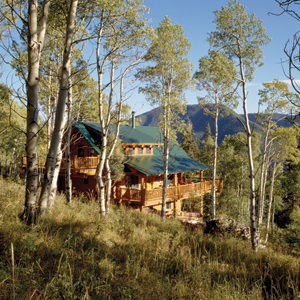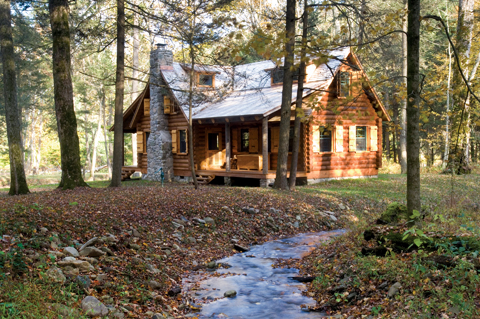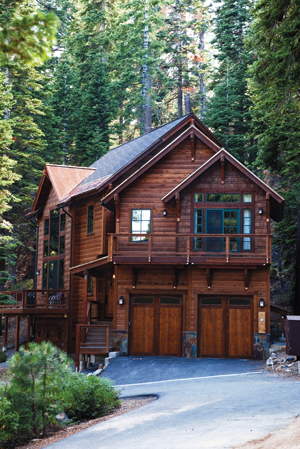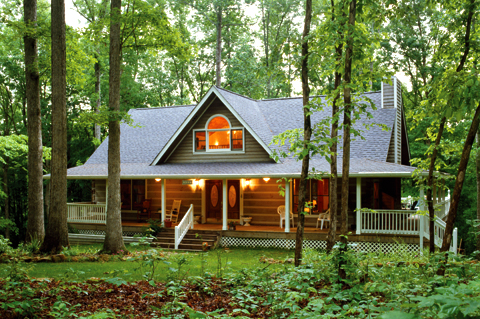A log home is a beautiful complement to any setting, no matter if it’s poised out in the middle of a wide-open prairie or hugging the shoreline of a lake or ocean. But there’s just something irresistible about a cabin in the woods. Nestled among the trees, a log cabin home or weekend camp against a deeply wooded backdrop just seems at ease and, well, right.
When designing and building your dream woodland log cabin home, there are a few factors to keep in mind. These can be divided into two sectors: your site and your home. Heed this advice from industry and government experts and you’ll be on your way to building a cabin that will be kind to the environment and that you’ll enjoy for a lifetime.
Your Site
To keep the wooded atmosphere of your area, you need a sizable lot, preferably an acre or more. A smaller lot would require too many trees to be cleared and it would lose the personality that drew you to the lot in the first place.
Unless you’ll be lucky enough to be able to tap into the public sewage system, before you put one nickel toward a down payment on the land, make sure it can pass a percolation or “perc” test. This test measures the absorption rate of the soil and determines whether it’s suitable for a septic field.

Photo by Roger Wade
If the land can’t pass the test, you likely can’t build on it.
You’ll want a piece of land that has a variety of tree species and individual stands of trees. Not only will this create a beautiful panorama throughout the seasons, but if blight hits a particular tree species, it won’t wipe out your entire grove, as it would if your lot only contained one or two species. Size and age count, too. Variety encourages a vital soil environment. The greater variety of species and sizes you have on your site, the better the chances for a long-term, healthy tree cover, according to a bulletin issued by the University of Georgia School of Forest Resources.
Ideally, you should own your land for a year before you break ground on your home. Follow it through each of the four seasons, taking note of how the landscape and the views change. This will help you determine the perfect place to site your home.
Try to build in an area on your lot that is the least forested. That way, you’ll minimize how many trees need to be taken down for construction vehicles and staging to make way for your new home. Not only is it the environmentally responsible thing to do, it will cost you less and you’ll better preserve the beauty of your wooded site. After all, isn’t that why you bought this land in the first place?
Protect your personal forest from construction damage. Clearly mark which trees are to be removed to make way for your home and which are not. And take care not to remove any unnecessarily. When a forest is thinned for construction, the trees that remain may respond poorly to building by-products, such as water run-off, excessive wind, insects, and exposure.
Create a wildfire defensible zone to prevent forest fire damage. FEMA (the Federal Emergency Management Agency) advises homeowners to keep a 30-foot perimeter around their homes free of trees. If you live on a hill, extend that perimeter down the hillside, as fire moves rapidly upward. And make sure that the trees that are closest to your home are pruned of dead branches to at least 15 feet from the ground.

Estemerwalt Log Homes
One more tip for preventing fire from damaging your home: Install spark arrestors in chimneys and stovepipes. Chimneys create a hazard when embers escape through the top. To prevent this, FEMA suggests homeowners install spark arrestors made of 12-gauge welded or woven wire mesh screen with half-inch openings across on all chimneys, stovepipes, and fuel-burning heater vents and make sure the top of the chimney is at least two feet higher than any tree or fixture within 10 feet of the chimney. Of course, it’s imperative that you keep your chimney free of creosote and debris.
After the site is prepared and before the logs are erected, get rid of any old or newly created tree stumps. Ants (especially carpenter ants), termites, wasps, and other insects love to nest in tree stumps. You don’t want them to make their home anywhere near your home. Don’t let them get comfortable.
Your Home
Expansive tree canopies surrounding your home mean one thing—the sun’s rays are filtered, so they don’t penetrate as deeply onto your site. This has its advantages and disadvantages. Here are a few key areas to address:
Foundation. Since soil will tend to stay moister after a rain and snow will have a harder time melting due to the diffused sunlight, make sure your foundation extends at least 18 inches above the ground before your first log course starts. This will help keep moisture away from the wood. Also important: Make sure the ground is graded properly—gently sloping away from your home.
Roof. Greg Grimes, a partner with Oostburg, Wisconsin-based Expedition Log Homes, suggests that for wooded areas, a metal roof is a smarter choice than an asphalt shingle roof, even though it’s more expensive. “Since the sun won’t dry rainwater on the roof as rapidly as it would in less densely forested areas, asphalt shingles can mold more easily,” he explains. “Metal roofs don’t mold.” There are some after-market products out there that are designed to help reduce the risk of roof mold and stains. Two products, ZincShield, a strip that is applied around chimney and seam flashing, and LiquidZinc, which can be applied to the entire roof, release zinc ions and minimize or eliminate molds and stains. Check out www.zincshield.com for more information.

Gutters. And while we’re on the subjects of roofs, don’t ignore your gutters. In a wooded area, your gutters will need to be inspected much more frequently than they would in other, less woodsy locales. You may want to inspect your gutters every month during spring and summer, and weekly during autumn, especially as you get closer to winter. Any water buildup in your gutters will freeze and cause potential ice dams that can leech moisture into your logs. Products like gutter guards can help reduce maintenance, but you still need to inspect them frequently.
Logs. Here’s a big benefit of a wooded site: Because the sun’s damaging UV rays won’t easily penetrate your surroundings, your stain will hold up longer and better than it will on homes that are more exposed. And though you will still have to inspect regularly for signs of unwanted moisture, if your stain and sealant were applied correctly, you shouldn’t have to reapply them as frequently as you would if your log home was subjected to direct sunlight.
Screened-in porches. This is a design element that just makes sense. Mosquitoes, flies, and other insects flock to the woods even more than we humans do. Extend your outdoor enjoyment all year long by enclosing at least one porch with a screen.
Outdoor access. All too often, exterior access points and living areas are designed as an afterthought. But when you’re building in a wooded area, it’s imperative that you plan them out of the starting gate, so you don’t disturb vegetation and trees needlessly after the structure of your home is erected. Plus, good circulation is an essential element of your home and will directly affect how satisfied you are with the results. As you’re drafting your plans, be sure to designate areas for sidewalks, driveways, parking, and turn-around areas, as well as patios, decks, gazebos, and other outdoor features. Then stake those out on your lot using a builder’s tape measure, a compass, and string. This will help you visualize how your plan will translate to the topography of your land and define which trees will have to be removed to make way for the construction. As construction gets under way, be sure your general contractor uses a protection barrier (a temporary fence enclosed with mesh netting) to protect the woodlands from the activity of the job site and create a clear line of demarcation for the crew.

